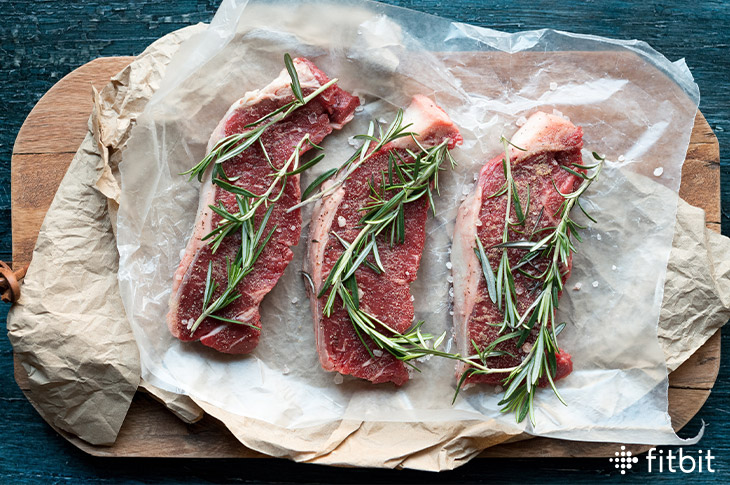
Red meat is no stranger to bad press. For years, headlines raised concerns about saturated fat and cholesterol. More recently, high-protein diets gave meat a comeback story, but the American Heart Association remains strict about artery-clogging animal fats. And now the news media is covering a cancer scare: a recent review by the World Health Organization positions meat, particularly the processed kinds, as a carcinogen. If you’re a meat eater, it’s understandable that you may be feeling slightly anxious.
To be clear, there’s a big difference between processed meat and fresh meat. Processed meat is preserved by smoking, curing, salting, or adding chemicals (like nitrites and nitrates), and includes ham, bacon, sausages, hot dogs, salami, and jerky. These choices are high in salt, fat, and chemicals, and they’re not the best ways to get your protein. But what about lean, clean, fresh red meat, like beef, lamb, and pork?
The Health Benefits of Lean Red Meat
Red meat can be great source of protein, which has been shown to help make you feel full. Lean choices are low in total fat and saturated fat—it has roughly the same amount of saturated and unsaturated fat, which might surprise some. And while it’s most known for iron, lean red meat also contains a host of other essential nutrients, like B vitamins, including B12, and minerals, like phosphorus, zinc, and selenium (an antioxidant that improves immune function and decreases cancer and heart disease risk). Take a look at what’s in an average serving.
| Nutrient | 3 oz Beef Sirloin | 3 oz Pork Tenderloin | 3 oz Lamb Loin |
| Calories | 150 | 159 | 138 |
| Protein | 26 g | 26 g | 22 g |
Total fat
|
4 g
|
5 g
|
6 g
|
| Cholesterol | 69 mg | 80 mg | 66 mg |
| Sodium | 56 mg | 55 mg | 65 mg |
| Iron | 9% DV | 7% DV | 8% DV |
| Zinc | 32% DV | 17% DV | 17% DV |
| Vitamin B12 | 20% DV | 14% DV | 23% DV |
| Selenium | 47% DV | 63% DV | 5% DV |
Beef top sirloin steak, lean meat only, trimmed of fat, cooked.
Pork tenderloin, lean meat only, cooked.
Lamb loin, lean meat only, cooked.
What Matters Is How Much Red Meat You Eat
With so many great health benefits, you don’t have to feel bad about dining on red meat—but the problem is many people eat way too much. In particular, most American men have a heavy hand when it comes to protein and could benefit from moving meat to the side of the plate, making room for more veggies.
The recommendation for how much red meat you can eat varies across different health organizations. The Dietary Guidelines for Americans suggest 5½ ounces of protein a day from all sources, and the absolute ceiling, based on the American Institute for Cancer Research’s recommendation, is to eat no more than 18 ounces of red meat per week.
If you have a varied diet, including different types of protein (like fish, poultry, eggs, nuts and legumes), aim for 9½ ounces of red meat spread across two to three meals a week. This means you can have a 3- to 4-ounce steak for dinner twice a week, and a 2- to 3-ounce roast beef sandwich once a week. Or, you could choose to go for a larger portion of 4 to 5 ounces of steak for dinner twice a week, skipping the lunch serving. Get the idea?
What to Buy: The Best Cuts
The best way to shop for red meat is to use your eyes—look for the least amount of visible fat on the outside and marbled throughout the meat. Ask your butcher for recommendations on the leanest cuts: sirloin, loin, tenderloin, and round are typically good choices, and ask for lean or extra lean ground beef, which is less than 10 percent fat by weight.
Spending a bit more on grass-fed meat is not only better for the environment, it’s better for your health, too. Grass-fed beef has less total fat, a healthier type of fat (more omega 3s!), as well as more vitamins and cancer-fighting antioxidants.
Cooking methods also impact the health of your meal. High-temperature grilling has been shown to form cancer-causing chemicals in meat, so it’s best to avoid charring. Instead, marinate lean cuts of meat for at least 30 minutes, coat in antioxidant-rich spices, and avoid those flames.
Consider the Environment
What’s good for your health is also good for the environment: You don’t have to be a tree-hugger to take notice of the environmental impact of eating meat. It’s huge. But from “flexitarian” to “vegetarian before 6” to “climate carnivore,” there are lots of ways to be more thoughtful and moderate about how and when you eat meat. Meatless Mondays is a great place to start, and pulses and other plant proteins are delicious alternatives to try.
The take-home message? Give weekly hot dogs, bacon, and sausages a skip. But enjoying a small serving of, lean, red meat (grass-fed, ideally) two to three times a week, as a part of a plant-rich diet, packed with vegetables, fruit, whole grains, nuts, and legumes, is a good healthy eating strategy.
This information is for educational purposes only and is not intended as a substitute for medical diagnosis or treatment. You should not use this information to diagnose or treat a health problem or condition. Always check with your doctor before changing your diet, altering your sleep habits, taking supplements, or starting a new fitness routine.

If you have questions about a Fitbit tracker, product availability, or the status of your order, contact our Support Team or search the Fitbit Community for answers.
Please note: Comments are moderated and may not appear immediately after submission.